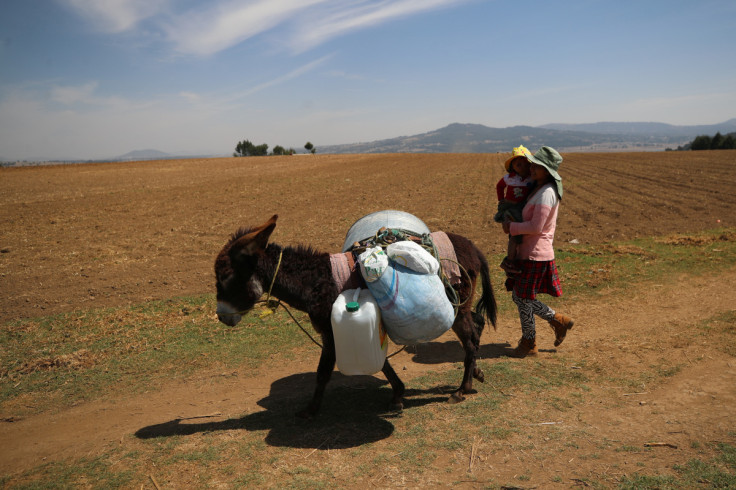Mexico City's Thirst For Water Lays Bare Inequalities, Changing Climate

Every day, at a well near her home in Central Mexico, Isabel Solis fills plastic jugs with river water and loads them on her donkey to lug home for the day's cooking, cleaning and drinking.
Solis, 64, lives on the banks of Mexico's Villa Victoria reservoir, which supplies water to the bustling capital hours away but does not reach her own faucets.
"Those with money are the ones who get water," Solis said.
Villa Victoria is part of the Cutzamala System, the source of water for about six million people in Mexico City and the surrounding state of Mexico.
Climate change, chaotic urban growth and inefficient infrastructure have strained Mexico's water supplies, pushing the Cutzamala System's stores to their lowest level in 27 years.
Water stress is a problem for much of the country. This month, some 200,000 residents in the city of San Luis Potosi have suffered water shortages for 22 days, the city's mayor said, after failures of a pipeline from a key reservoir.
Nearly half of Mexico's municipalities were experiencing drought in late March, according to national water agency CONAGUA.
"We are seeing climate change in the form of droughts in the country's center and north, but we also have the opposite effects in the form of abundant rains in the south and southeast," said CONAGUA's director German Martinez.
Mexican President Andres Manuel Lopez Obrador has pushed companies to invest in the country's south, arguing that water is too sparse in the more industrialized north. The drive almost threatened to derail a $5 billion factory deal with Tesla this year.
Infrastructure also plays a role, with leaks plaguing the network that lugs water up to and across Mexico's high-altitude capital.
"The distribution system is very deficient," said Martinez, adding that nationwide an average of 30% to 40% of water supply is lost to leaks.
While the sprawling capital region's rainy season helps replenish reservoirs, most rainwater is not captured.
It does not help that Mexico City, North America's largest metropolis, "grew without adequate planning," said Ramiro Gutierrez, an engineer and assistant manager of drinking water supply at CONAGUA.
Gutierrez added that "rainwater no longer absorbs into subsoil that is now covered by roads or houses," and that strengthening storms are concentrating rain water into fewer days and making it harder to capture.
Officials are taking steps to increase the capital region's supply. Last year, the governments of Mexico City and the state of Mexico announced a 300-million-peso ($16.55 million) canal upgrade with CONAGUA in the state of Michoacan to increase the water flowing to the El Bosque reservoir, which officials say will provide more water to communities surrounding the Cutzamala System.
Mexico City is also tapping alternative sources of water outside the Cutzamala System, including by replacing wells in the Zumpango area in the state of Mexico.
In late March, Mexico's air force began what is known as cloud seeding over the Cutzamala System, a process of releasing silver iodine into clouds to stimulate condensation and ultimately rainfall.
Air Force meteorologist and Second Captain Ricardo Torres told Reuters the strategy was "very successful" in the states of Nuevo Leon and Tamaulipas and will be employed until May 7 to try to restore the Cutzamala System's reservoirs.
Mexico's constitution ensures the right of access to water, adding urgency to officials' efforts. But for people like Israel, who lives just a few minutes' drive from the Cutzamala System's water treatment plant and asked not to use his last name, the constitution's promise is increasingly distant.
"In recent years things have become more complicated. The water is more scarce," Israel told Reuters while filling a tank at his home with water he brought from a river to use for washing and household tasks.
"Before, we didn't have to struggle so much with water."
($1 = 18.1216 Mexican pesos)
© Copyright Thomson Reuters 2024. All rights reserved.




















